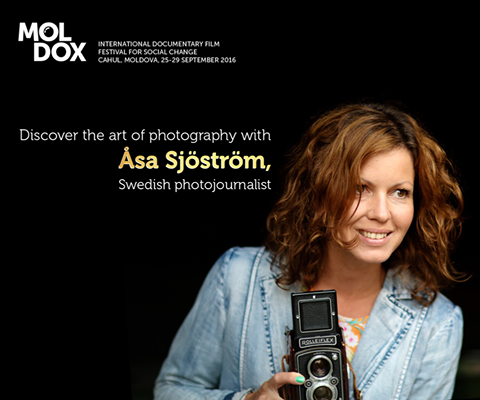Learn and improve how to make more powerful pictures and story composition by analyzing real-life situations and managing potential problems at the Social Documentary Photography Workshop with the tutor Åsa Sjöström.

Åsa Sjöström graduated from the school of photojournalism in Sweden, Nordens Fotoskola in 2002. Her work focus on international understanding, human equal rights, and the situations of women and children around the world. As a photojournalist, Åsa wants to create awareness and intimacy, with a blending of documentary, fine art and a personal intent. Åsa has been awarded twice in World Press Photo, both times with pictures taken in Moldova, Poyi and several times in Swedish Picture of the Year Award. Her work has been given numerous Grants such as Catchlight Activist Award 2015, the Swedish Arts Grants Committee 2015 and Anna Lindh memorial development grant for her work in Moldova 2006. Honorable mentions in Unicef Picture of the year Award and Swedish Red Cross journalism Award. Recent exhibitions are St Brieuc Photoreporter Festival for her work in Moldova, and she has been selected for the annual subway art exhibit at Mariatorget in Stockholm 2016. Gallery Kontrast in Stockholm exhibited her work Secret Camps Dec-January 2015-2016.
Find more about Åsa in the interview especially for MOLDOX.
- Dear Åsa your photography portfolio has a number of pictures taken in Moldova, and they are highly appreciated with numerous international prizes, why did you choose our country as inspiration?
Well, after finishing my photojournalism studies I had been working for several of Swedens major newspapers over a period of one and a half year, and I wanted to start working with my own project without any deadlines. I Always thought that I had to leave the people, villages, cities or countries way to early, I felt it wasn´t right or fair to the people in my photographs. I wanted to spend time to get to know people, the villages, the cities and somehow the countries, so it felt like I could bring home a more authentic and intimate story. My Moldova-project came to me as a coincidence, I had never heard about Moldova and that made me curious. And now, every time I come back to Moldova I feel that I`m getting closer to the people I photograph and it´s easier for me to understand the small complexities that surrounds the people in your small and sometimes vulnerable country. The last three years I have come back to the same villages, visiting the same families and I can see the children grow up and what dreams and what obstacles they have to face. By returning to the same places, also gives people confidence in me as a photographer. in some way, Moldova has become a love story for me, almost like my second country.
- This time you will be in Moldova for the ”MOLDOX Festival” as a mentor for the ”MOLDOX LAB”, what does mean ”Social Documentary Photography”?
Social documentary is when you are working with covering complicated topics, related to social injustice and socially vulnerable people. Working with sensitive issues is always very emotional, both for the people in my photographs and for me. I think it´s important to question yourself:
How much can I expose the people in my photographs? Will they get in any danger because of my pictures? Are they aware of how much impact an image can have, maybe for the rest of their life? How close can you get? Can I get close enough? and so on. I think all good photojournalists struggle with these ethical questions, at least I do. Sometimes I wish I was a doctor so I could actually help the person that stands in front of me. But I am a storyteller, I work in a broader context and that is also something the world needs. We need to know whats going on and that drives me to continue. The power of journalism is so important, we are the peoples voice and together with them we bring big and small topics out and share it to the world.
- What are the main topics of your workshop and what is the main information that you will share with the ones that signed up for it?
The most important thing is that you have done your research, to be well prepared and that you know why you are documenting the topics and the people that brings your attention.
I always work with projects that engage me. Bringing attention to people in vulnerable situations is of course always difficult. Therefor it´s very important to respect and be truly honest to the people you meet.
Never imaging a picture before you actually have it. Be open to the reality, because it´s almost never what you expect.
- What is the power of the photography?
The power of photography/photojournalism can be very strong, people have to face the facts whats going on in the world through pictures. By combining great content with a personal intent makes photography even more powerful, and photographers visual language is just as important as a writers language, you have to create your own artistic language to be able to stick out and to gain viewers interest. That makes an impact and a difference between ”random” pictures that you tend to forget, from pictures that stick into your mind. Photojournalists has a responsibility as storytellers to share peoples stories to the world. That is powerful.
- Could you bring some examples of photography that brought a social change during the history?
Below are some classical pictures that brought change to the world. And of course there are many more to add. Both big and small.





